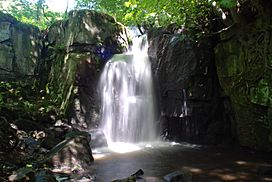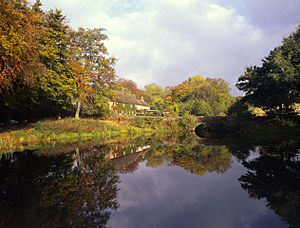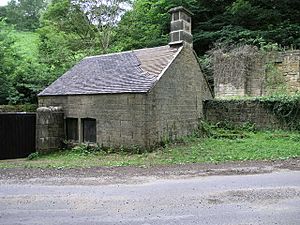Lumsdale Valley facts for kids
Quick facts for kids Lumsdale Valley |
|
|---|---|

Lumsdale Falls (no public access)
|
|
| Geography | |
| Location | Derbyshire, England |
| Rivers | Bentley Brook |
Lumsdale Valley is a beautiful, steep valley in the Peak District of Derbyshire, England. It is close to the town of Matlock. This valley is famous for its old water-powered mills.
Lumsdale Valley is a special place called a Scheduled Monument. This means it is protected because of its history. The Arkwright Society owns and looks after the valley. They have cared for it since 1976. The valley is also part of the Lumsdale Conservation Area. This area was set up in 1980 to protect its unique features.
The monument includes many old water-powered mills. It also has other fragile industrial buildings and remains. The main part of the valley, where the falls are, is private. It is no longer open for everyone to visit.
The name Lumsdale might mean 'valley of chimneys'. This comes from the Scottish word lum, meaning chimney. It shows the area's industrial past. Another idea is that it means 'valley of water pools'. This comes from the English word lumb, meaning a place with a pool.
Water Features

The Bentley Brook flows through Lumsdale Valley. It then joins the River Derwent. This brook was very important for powering the old mills.
The Upper Pond was built in the 1780s. Watts, Lowe and Co. built it to supply water for their cotton mill. The dam wall broke in 1947, and the pond has filled with mud since then. It is now a special nature reserve.
The Middle Pond was also built in the 1780s. It was dry and overgrown for a long time. In 2014, it was restored with money from the Heritage Lottery.
The Lower Pond was first a quarry. In 1850, it was changed into a reservoir to store water.
Lumsdale Falls are pretty natural waterfalls below the Lower Pond. Remember, the central part of the valley, including the falls, is private. You cannot visit them anymore.
Old Mills of Lumsdale
Lumsdale Valley has many old mill buildings close together. These mills were used for different industries. They processed lead, textiles, paint, and timber. The mills and their water systems date back to the 1600s. This water-powered industrial area is very important for history and archaeology in the UK.
The Bone Mill is now just overgrown ruins. In the 1600s, it was used to melt lead. Later, it was used to crush bones until the 1920s.
The Paint Mill was built around the 1600s. It was first used for bleaching and melting lead. Later, it became a corn mill. After that, it ground white barytes for the paint industry.
In 1749, two furnaces for smelting (melting) lead were in a building. This building is now known as Pond Cottages. Later, it was changed into homes for workers of Watts, Lowe and Co.'s cotton mill.
Richard Arkwright built the world's first powered cotton-spinning factory. It was in nearby Cromford in 1771. After Arkwright's patents (special rights) ended in 1785, a new cotton mill was built. Watts, Lowe and Co. built this three-storey, water-powered mill. However, the company went bankrupt by 1813.
John Garton then bought the mill to bleach textiles. It was called Gartons Mill. Today, it is known as the Lower Bleach Works. It closed in 1929. The Upper Bleach Works were built in the early 1800s. The Smithy is connected to the Lower Bleach Works. It is a Grade II listed building, meaning it is historically important.
The Saw Mill was built in the 1850s. It first ground minerals for paint. Later, it became a saw mill, cutting wood.


